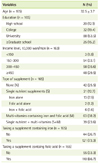1. Cox JT, Phelan ST. Nutrition during pregnancy. Obstet Gynecol Clin North Am. 2008. 35:369–383.

2. Scholl TO. Maternal nutrition before and during pregnancy. Nestle Nutr Workshop Ser Pediatr Program. 2008. 61:79–89.

3. Tamura T, Picciano MF. Folate and human reproduction. Am J Clin Nutr. 2006. 83:993–1016.

4. Goonewardene M, Shehata M, Hamad A. Anaemia in pregnancy. Best Pract Res Clin Obstet Gynaecol. 2012. 26:3–24.

5. Korean Nutrition Society. Dietary Reference Intakes for Koreans. 2010.
6. Kang MH, Chang NS. Effect of dietary folate intake on serum folate levels of pregnant and lactating women. Korean J Nutr. 1993. 26:433–442.
7. Kim EK, Lee KH. Assessment of the intake and availability of dietary iron and nutrition knowledge in pregnant women. Korean J Community Nutr. 1998. 3:53–61.
8. Kim EK, Lee KH. Iron status in pregnant women and their newborn infants. Korean J Nutr. 1999. 32:793–801.
9. Lim HS, Lee JI, Lee JA. Folate status of Korean pregnant women and their pregnancy outcomes: Across-sectional study. Korean J Nutr. 1999. 32:592–597.
10. Yu KH, Yoon JS. A cross-sectional study of nutrient intakes by gestational age and pregnancy outcome(I). Korean J Nutr. 1999. 32:877–886.
11. Lee JI, Lim HS. A longitudinal study on maternal iron and folate status during and after pregnancy in Korean women. Korean J Community Nutr. 2001. 6:182–191.
12. Joung HJ, Choi BS, Shin JJ, Yoon SD, Yoon H. The dietary intake of pregnant women in Daegu area. Korean J Community Nutr. 2003. 8:538–546.
13. Jang HA, Ahn HS. Serum iron concentration of maternal and umbilical cord blood during pregnancy. Korean J Community Nutr. 2005. 10:860–868.
14. Yoon JS, Park JA, Son SM. The iron status and diet quality of pregnant women during the first five months of pregnancy. Korean J Community Nutr. 2003. 8:803–813.
15. Cho JH, Ahn HS, Bae HS. The use of iron supplements of pregnant women and pregnancy outcome. Korean J Community Nutr. 2009. 14:327–339.
16. Centers for Disease Control and Prevention. Recommendations to prevent and control iron deficiency in the United States. MMWR Recomm Rep. 1998. 47:1–29.
18. Ahn YJ, Lee JE, Paik HY, Lee HK, Jo IH, Kimm KC. Development of a semi-quantitative food frequency questionnaire based on dietary data from the Korea National Health and Nutrition Examination Survey. Nutritional Sciences. 2003. 6:173–184.
19. Korean Nutrition Society. Recommended Dietary Allowances for Koreans. 2000. 7th revision.
20. Han YH, Yon M, Hyun TH. Folate intake estimated with an updated database and its association to blood folate and homocysteine in Korean college students. Eur J Clin Nutr. 2005. 59:246–254.

21. Choi HM. Nutrition in pregnancy. Korean J Obstet Gynecol. 2008. 51:481–491.






 PDF
PDF ePub
ePub Citation
Citation Print
Print






 XML Download
XML Download